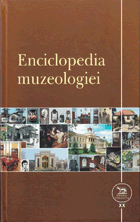Encyclopedia of Museology of the Republic of Moldova is a work dedicated to the museum world of the country. Its content focuses on the most significant museums, the most remarkable personalities in the field. An encyclopedia about museums can not cover everything, but the selected and presented materials reflect the museum sphere in detail.
Encyclopedia of Museology of the Republic of Moldova appeared in late 2011, at the Bons Offices Publishing and Printing House, Chisinau. The authors of the volume are Elena Ploșnița, Ph.D. and Mihai Ursu.
Encyclopedia of Museology of the Republic of Moldova contains ca 300 articles placed in alphabetical order, which provide clear and objective information about the Moldavian museum world since the 19th century to the present. It is supplemented by the List of Abbreviations, summaries in four languages, List of Sources, Bibliography, Index of Articles, Index of Names, and Index of Localities. Many of the articles have a historical prelude: every phenomenon is presented in its development. Most articles are accompanied by Works and Bibliography, which contain the most important materials on the subject or on the life and work of museums, scientists, and people of culture. Both in the Works and Bibliography, the works are presented in chronological order, regardless of the language they were written.
The work comprises three main blocks of information: museological material (terminology, concepts); historical material (information on museums of the past, different societies, contemporary museums and their collections, etc.); biographical material (information about the museum specialists, collectors, museum supporters, etc.). All the articles are presented in alphabetical order, regardless of the block of information.
The Encyclopedia includes black and white and color illustrations. Special attention was given to illustrations reflecting museum pieces; there are also given images of museum buildings and photos of personalities who have found the right place in the pages of the Encyclopedia. In black and white there are given presently nonexistent museums of the past, collectors, scientists, and museum specialists who are no longer among the living. In color there are presented pieces from the museum collections, buildings of the museums, which are now open to the public, and specialists who are working in the museums today. Most of the photographs were made by Iurie Foca.
The Encyclopedia as any work can be improved; it is a beginning that can be continued by colleagues, curators, historians, and others, in one or another way. We will be grateful to those who would have the courage to continue the presentation of MUSEUM phenomenon in other scientific publications.

















































